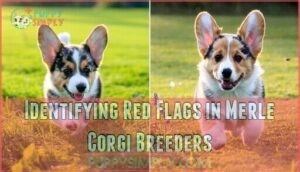This site is supported by our readers. We may earn a commission, at no cost to you, if you purchase through links.

This striking look comes from a specific gene that affects pigment distribution, often paired with bright blue eyes that’ll make you do a double-take.
However, this beauty comes with a price tag that’s typically double a regular Corgi’s cost, plus serious health risks including potential deafness and vision problems.
The merle gene is like rolling dice with your dog’s wellbeing, making breeder selection absolutely critical for your future companion’s health and happiness.
Table Of Contents
Key Takeaways
- You’ll pay double the price for a merle Corgi compared to regular ones, with costs ranging from $1,200 to $4,500 due to their rare coat pattern and breeding complexity.
- You can only find true merle genetics in Cardigan Welsh Corgis – if you see a merle Pembroke, it’s actually a crossbreed mixed with another merle breed.
- You’re risking serious health problems including deafness, blindness, and vision issues, especially if breeders irresponsibly mate two merle dogs together creating "double merle" puppies.
- You must choose ethical breeders who conduct genetic testing and health screenings – avoid puppy mills and breeders who won’t let you visit or lack proper health documentation.
What is a Merle Corgi?
You’ve likely seen pictures of Corgis with stunning mottled coats that look like someone splashed paint across their fur – that’s a merle Corgi.
These dogs carry a special gene that creates irregular patches of light and dark colors, typically resulting in blue-gray marbling mixed with black, white, and sometimes tan markings, which is a key characteristic of the Corgi breed.
The merle gene transforms ordinary Corgi coats into living masterpieces of swirled blues, grays, and marbled patterns.
Physical Features of a Merle Corgi
The beauty of a merle corgi lies in its striking coat patterns that make each dog truly one-of-a-kind.
You’ll instantly recognize these Cardigan Welsh Corgis by their distinctive marbled appearance, where darker colors blend seamlessly with lighter patches across their coat.
Their coat colors create a mesmerizing patchwork of blues, grays, blacks, and sometimes reds or tans.
The merle gene dilutes pigments randomly, leaving some areas untouched while lightening others.
This affects their skin pigmentation too, often creating pink or mottled noses.
Key physical features include:
- Eye color variations – striking blue eyes, brown eyes, or heterochromia (different colored eyes)
- Merle markings – irregular patches scattered across the body, creating a marble-like effect
- Size variations – standard Cardigan build with sturdy, low-to-ground body structure
- White flashings – distinctive white markings on chest, face, legs, and tail tip
Their body structure remains typically Corgi – short legs, fox-like face, and that famous wiggling rear end that’ll steal your heart.
Merle corgis, like their counterparts, can also carry the gene for a plush double coat.
How Merle Corgis Are Created
Understanding how merle corgis are created starts with simple genetics.
The merle gene is a dominant trait that requires only one copy from either parent to produce the distinctive coat patterns you see.
Here’s the catch: only Cardigan Welsh Corgis naturally carry this gene.
If you’re seeing a merle Pembroke corgi, it’s actually a crossbreed – usually mixed with a Cardigan or another merle breed like an Australian Shepherd.
Responsible breeding practices involve pairing one merle parent with a non-merle partner.
This genetic inheritance pattern creates roughly 50% merle puppies without the severe health risks.
The Cardigan influence explains why purebred merles are less common than crossbred versions in today’s market.
Are Merle Corgis Prone to Health Problems?
When you’re considering a merle Corgi, you’ll want to know that these beautiful dogs can face serious health challenges.
The striking coat pattern that makes them so appealing comes with increased risks of vision problems, hearing loss, and other genetic issues that don’t affect regular Corgis, especially if they carry two copies of the merle gene.
Common Health Issues in Merle Corgis
Genetics don’t always play fair in the case of merle corgi health. These stunning pups face unique challenges that regular Corgis don’t encounter. The merle gene affects more than just coat color—it impacts critical body systems like vision, hearing, and skin integrity.
Your merle Corgi might develop several concerning health issues throughout their lifetime:
- Vision impairment ranging from partial sight loss to complete blindness
- Hearing loss affecting one or both ears, with deafness occurring in 25% of cases
- Spinal problems due to their short-legged structure and genetic predisposition
- Skin cancer from increased sun sensitivity and irregular pigmentation
- Double Merle risks creating severe complications when both parents carry the gene
Health risks don’t mean you can’t enjoy life with a merle Corgi. Regular vet checkups, genetic testing, and staying alert to early warning signs help catch problems before they become serious. Choose breeders who prioritize health over flashy colors. Breeding two merles can lead to double-merle health risks.
The Risks of Breeding Two Merle Corgis
Beyond the individual health concerns, breeding two merle corgis together creates what’s known as "double merle health" risks. This practice carries serious genetic consequences that responsible owners should understand.
When you breed two merle corgis, you’re rolling dice with devastating outcomes. Each puppy has a 25% chance of inheriting the double merle gene combination. These "double merle" offspring face severe health risks including complete deafness and blindness. It’s like playing Russian roulette with innocent lives.
Breeding two merle corgis together is genetic gambling where innocent puppies pay the ultimate price.
Double merle dogs frequently suffer from hearing impairments and vision problems.
The ethical concerns surrounding this practice include:
- Preventable suffering – Double merles often experience lifelong disabilities
- Genetic testing alternatives – DNA screening helps identify safer breeding pairs
- Breeding alternatives – Pairing merles with non-merles eliminates these puppy outcomes
Smart breeders prioritize merle corgi genetics over flashy coat patterns.
How Much Do Merle Corgis Cost?
You’ll pay more for a merle Corgi than a regular one, with prices often reflecting their rare coat pattern and breeding complexity.
Several factors influence the final cost, from the breeder’s reputation to the puppy’s specific genetics and health testing.
Factors Affecting The Cost of Merle Corgis
Several key factors drive merle corgi price variations beyond basic health concerns.
Your location’s demand substantially impacts costs, with urban areas typically commanding higher prices.
Here’s what you’ll encounter:
| Factor | Impact on Price |
|---|---|
| Breeder reputation | Premium pricing for established breeders |
| Pedigree lineage | Champion bloodlines increase costs substantially |
| Health guarantees | Thorough testing raises puppy prices |
Coat rarity makes merle corgi for sale listings expensive, while puppy mills offer cheaper alternatives with hidden risks.
The average corgi price can range widely based on these factors.
Pricing Range for Merle Corgi Puppies
Merle corgi price tags can make your wallet feel lighter than expected.
These stunning pups typically range from $1,200 to $4,500, with some exceptional bloodlines reaching $6,000 or more.
Color rarity plays a huge role—blue merles command higher prices than other variations.
Breeder reputation substantially impacts costs.
Reputable breeders who conduct health testing, provide health guarantees, and offer proper socialization charge premium prices.
You’re paying for peace of mind and healthier puppies.
Pedigree influence matters too—champion bloodlines cost more but often come with superior genetics.
Location impact affects pricing considerably.
Urban areas typically see higher puppy prices than rural regions.
Included services like initial vaccinations, microchipping, and starter supplies add value but increase costs.
Avoid puppy mills offering "bargain" merle corgi puppies under $800.
These operations often cut corners on health care and breeding practices.
Remember, a higher upfront investment with reputable breeders usually saves money on future veterinary bills and guarantees you’re getting a healthier companion.
Is It Ethical to Purchase a Merle Corgi?
You’re probably wondering if buying a merle Corgi supports good breeding practices or contributes to health problems in dogs.
The answer depends entirely on whether you choose a responsible breeder who follows ethical guidelines and avoids dangerous breeding combinations.
Identifying Ethical Breeders
Finding the right breeder feels like searching for a needle in a haystack, but you’ll know when you’ve found one. Reputable breeders prioritize breeder transparency by openly sharing their breeding environment and allowing visits.
They’ll provide thorough genetic testing results for both parent dogs, proving they’re not running puppy mills focused on profit over health. Look for AKC-registered breeders who offer health guarantees covering potential health issues.
Ethical breeding means proper puppy socialization from day one – you should see well-adjusted pups in clean, loving environments. Red flags include breeders who won’t let you visit, lack health documentation, or focus solely on merle coloring.
To find one, consider researching an ethical corgi breeder. Ask about the breeder’s membership in recognized Corgi clubs. Members follow strict breeding standards that protect against genetic complications.
Remember, legitimate breeders will question you too – they want their puppies going to good homes.
Responsible Breeding Practices for Merle Corgis
Looking for responsible breeding means you’re protecting your future merle corgi from preventable health issues.
Ethical breeders prioritize genetic testing over profit margins, screening both parents for the merle gene and related health conditions.
They’ll never breed two merle dogs together – avoiding double-merles is non-negotiable since these puppies face severe vision and hearing problems.
Reputable breeders understand canine genetics inside and out, openly discussing potential risks while showing health certificates for breeding pairs.
They’ll quiz you about your experience and living situation because puppy health matters more than quick sales.
Breeder screening works both ways – if they’re not asking questions about your preparedness, that’s your red flag to walk away.
These breeders understand the risks of double merle breeding and take precautions.
What Do Merle Corgis Look Like?
You’ll recognize a merle Corgi by its distinctive mottled coat pattern that creates irregular patches of light and dark colors across a base of blue, red, or sable.
These eye-catching dogs often display striking blue eyes or heterochromia, where each eye shows a different color due to the merle gene’s effect on pigmentation.
Physical Appearance of Merle Corgis
Understanding the ethics of purchasing these dogs brings us to examining what makes them so visually striking.
Your merle corgi displays a truly one-of-a-kind appearance that’s impossible to replicate.
The coat pattern creates a marbled effect with dark patches scattered across a light-colored coat, resembling an artist’s canvas.
This unique genetic expression affects more than just fur color.
Here’s what makes merle corgis stand out physically:
- Coat Patterns – Blue, red, or sable merle with irregular splotches
- Eye Color – Often blue eyes or heterochromia (different colored eyes)
- Body Markings – White patches on chest, legs, face, and neck
- Size Variations – Cardigan merles tend to be larger than Pembrokes
These coat colors and unique features make each merle corgi a walking work of art.
Differences Between Merle Corgis and Other Coat Colors
Spotting the difference between merle corgis and solid-colored corgis is like comparing a watercolor painting to a solid block of color.
The merle gene creates dramatic visual impact through pigment dilution, transforming what would be solid black into stunning blue-gray patches scattered across white fur.
While standard corgi colors include red, sable, black, and brindle in uniform tones, merle coat colors showcase irregular mottled patterns that make each dog unique.
Color genetics work differently here – the merle gene dilutes random sections of pigment, leaving some areas untouched while lightening others.
Pattern variations in merle corgis can include blue eyes or heterochromia, which you won’t see in solid-colored corgis.
Breed standards recognize these distinctive features in Cardigan Welsh Corgis, where the genetics naturally occur.
You’ll notice merle corgis often get mistaken for other colors due to their complex, ever-changing appearance under different lighting conditions.
Are Breeders Who Breed Merle Corgis Reputable?
You’ll find that breeder reputation varies widely in the merle Corgi world, with some following strict health testing while others prioritize profit over puppy welfare.
The key is knowing how to spot responsible breeders who conduct genetic testing and avoid breeding two merle dogs together, versus those who cut corners and create health risks, which involves understanding the importance of genetic testing.
Characteristics of Reputable Breeders
Trust forms the cornerstone of any relationship between you and a merle Corgi breeder. Reputable breeders prioritize your future pet’s wellbeing over quick profits, making transparency practices their standard operating procedure.
Ethical breeding starts with genetic testing for both parent dogs. Trustworthy breeders screen for hip dysplasia, eye abnormalities, and hearing issues that commonly affect merle Corgis. They’ll gladly share test results and explain what they mean for puppy health.
Here are five hallmarks of reputable breeders:
- Comprehensive genetic testing – Tests both parents for hereditary conditions before breeding
- Written health guarantees – Provides contracts covering genetic defects for at least two years
- Puppy socialization programs – Exposes young dogs to various sounds, textures, and experiences
- Thorough buyer screening – Asks about your living situation, experience, and long-term commitment
- Ongoing support – Offers guidance throughout your dog’s life and takes back dogs if needed
Quality breeders view breeding ethics as non-negotiable, ensuring health issues don’t overshadow the joy of Corgi ownership. Similarly, a mixed breed like the Corgipoo requires careful consideration, as they’re prone to hip and eye issues.
Identifying Red Flags in Merle Corgi Breeders
Many scammer breeders exploit the merle corgi’s popularity, so you’ll need to spot warning signs before it’s too late. Double Merle breeding represents the biggest red flag – trustworthy breeders never mate two merle dogs together because it creates puppies with severe health problems.
Watch for these critical warning signs:
- Health testing absence – Ethical breeding requires genetic screening, yet puppy mills skip this expensive step
- Unrealistic guarantees – Promises like "perfect health forever" signal dishonest practices
High pressure sales tactics and lack of knowledge about merle genetics also expose problematic breeders. They’ll rush you into decisions or can’t explain basic inheritance patterns. Legitimate breeders welcome questions, provide health clearances, and let you meet parent dogs.
Checking for proper genetic screening is essential for identifying reputable breeders. They understand merle breeding nuances and prioritize puppy welfare over profits, creating a stark contrast with mills focused solely on money.
Frequently Asked Questions (FAQs)
What is a blue merle Corgi?
A blue merle Corgi displays a striking coat pattern with light and dark patches creating a marbled appearance.
You’ll notice gray, black, and white colors mixed together, often with tan markings and sometimes beautiful blue eyes.
Is Merle a Pembroke Corgi?
No, you can’t get a purebred Merle Pembroke Corgi.
Pembroke Welsh Corgis don’t naturally carry the merle gene – only Cardigan Welsh Corgis do.
Any Merle Pembroke is actually a crossbreed.
How does Merle affect a Corgi?
Like painting with watercolors on wet paper, merle creates unpredictable patches throughout your Corgi’s coat.
This dominant gene dilutes pigments, causing distinctive mottled patterns while potentially affecting eyesight, hearing, and overall health—especially in double merles.
Are blue merle Corgis rare?
Yes, you’ll find blue merle Corgis are quite rare.
They’re only naturally found in Cardigan Welsh Corgis, not Pembrokes.
The distinctive mottled coat pattern makes them highly sought after among Corgi enthusiasts.
Do Merle Corgis have mottled patches?
You’ll notice merle Corgis have distinctive mottled patches created by the merle gene.
These irregular blotches appear on a lighter background, creating beautiful marbled patterns in blue, red, or sable variations.
What color is a Merle Corgis?
Ever wondered what makes these pups so striking?
You’ll see distinctive mottled coats with irregular patches of blue-gray, black, or red mixed with lighter areas.
White markings often appear on their chest, legs, and face too, which can be considered a striking feature.
How rare is a merle Corgi?
Merle Corgis are quite rare since only Cardigan Welsh Corgis naturally carry the gene.
You’ll find them less commonly than standard colors, making them highly sought-after and typically more expensive to purchase, because they are rare.
Do merle Corgis have health issues?
Health problems can definitely affect these beautifully patterned dogs.
You’ll find they’re prone to hearing loss, vision issues, and skin cancer.
Double merles face the highest risks, making responsible breeding absolutely essential.
Is merle natural in Corgis?
Like finding a rare wildflower in your garden, the merle gene naturally occurs only in Cardigan Welsh Corgis.
You won’t find it in purebred Pembrokes—they’d need mixing with other breeds to express this beautiful pattern.
Are merle dogs good or bad?
You can’t label merle dogs as simply "good" or "bad."
They’re beautiful companions with unique coats, but breeding requires careful genetics knowledge to avoid serious health issues.
Deafness and blindness are examples of the serious health issues that can occur if genetics are not carefully considered.
Conclusion
Consider Sarah, who fell in love with her merle Corgi’s stunning coat but later faced $3,000 in veterinary bills for hearing issues.
Your merle Corgi decision shouldn’t be taken lightly. These beautiful dogs require careful breeder selection, ongoing health monitoring, and financial preparation for potential medical needs.
While their striking appearance captivates many owners, responsible ownership means understanding the genetic risks involved. Research thoroughly, choose ethical breeders, and make certain you’re prepared for both the joys and challenges of merle Corgi ownership, including being aware of the potential for hearing issues.
- https://www.akc.org/dog-breeds/pembroke-welsh-corgi/
- https://www.thekennelclub.org.uk/dog-breeding/first-time-breeders/what-is-merle/
- https://www.instagram.com/apollo.the.merle/
- https://cardigancorgis.com/cwcca/breed/colors/color-genetics-2005/
- https://www.animalwised.com/how-common-is-heterochromia-in-dogs-2346.html













